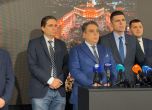

We talk to James T. Robinson - in charge of F-16 International Business Development at Lockheed Martin about the deal for the F-16 fighters.
- F-16 Block 70. Does that aircraft exist? Because Gripen said it doesn't exist yet.
- Yes, it does exist. The first version of Block 70 is called F-16V. What we've done is upgrading the existing F-16 airframes, a new radar, new computers, new cockpit and an advanced flight system with safety features. All that technology is on the F-16 Block 70.
- Certainly, the technology is available. Another certainty is that its best advantage is the 12 000-hour airframe. F-16 used to be manufactured in the plant in Texas which no longer exist. Where will the airplanes for Bulgaria be produced?
- We used the equipment we had in Fort Worth, Texas, where we have produced thousands of F-16s. And we moved that equipment to South Carolina.
- Does the South Carolina plant already work?
- Absolutely. It is a well-established facility for Lockheed Martin that makes repairs, maintenance and now will build F-16.
- When will the first F-16 Block 70 be ready and whose will it be - to Bahrain, Slovakia or Bulgaria?
- It will be for Bahrain. We still can't give an exact time on when because this is sensitive data for our Bahrain customer. We certainly will start building the jets this year for Bahrain.
- When will the first plane for Bulgaria be ready?
- We get that question a lot. What we can say is that this is part of the discussions between the US government and the Bulgarian government. But what Lockheed found is a way to accelerate the deliveries of the aircraft. And if the negotiations go well, we will be able to deliver the aircraft much sooner than originally planned and to meet the Bulgarian airforces' needs.
- A press release on the Lockheed Martin website from June 2018 said the price for Bahrain is 61 million EUR per aircraft. This message was widely-spread here. What's the explanation?
- We have to keep in mind that deals include a lot more than just the aircraft. So, the total package approach for Bulgaria includes the eight aircraft, four sniper targeting pods, spare parts, training for the pilots and maintainers, and simulator.
- What does Bahrain have less?
- I am not an expert on the Bahrain deal, I am sorry. But their jets are not cheaper than Bulgaria's.
- What part of the price is for the aircraft itself? What part of it is for the equipment and what part is for the training?
- This is part of the government-to-government negotiations.
- The Bulgarian government decided that it can spend 1.5 billion leva for the fighters. On the 16th of January the parliament will most probably annul this decision. The reason is the supposed deal for the F-16 which doesn't fit into this financial frame.
- Once again, we as Lockheed cannot comment on the price of the deal because of the fact that it is a government-to-government negotiation. The key is that there are so many other parts of the program that we as Lockheed Martin don't provide, including the engines for the airplanes.
Yes, some of our competitors offer cheaper prices but their offer doesn't include all the components in our package. This, for its part, can cost more and who know what the final price would be.
Once again, I will say that a key to our proposal is that everything is included. So when the aircraft arrives here, in Bulgaria, it will be able to fly the next day. With no need for a third-party approval or from other governments.
- Does the offer include long-range air combat missiles?
- That's a classified conversation. But their is a radar, sniper targeting pods, helmet navigating system. Together with the AMRAAM missiles and the AIM9X missiles this is the most lethal combination in the world.
- The EU has banned offset programs. But there's still a little bit of a gap for industrial cooperation. Does Lockheed Martin plan any industrial cooperation which would be linked to this specific aircraft?
- Yes, Lockheed plans industrial participation in accordance with all laws and procedures. We look forward to developing procedures and programs together with the Bulgarian industry and education.
- Even the best machines get broken sometimes. What repairs would be made in Bulgaria and for which ones the airplanes would need to leave our borders? And my next question is: where will these repairs be made - in the US or some other country?
- One of the strengths of the F-16 is that for the 12 000 hours of their airframe they will never leave Bulgaria. All the work would be done on the airplane itself here, in Bulgaria. Some components - the engine, the avionics - may need to be refurbished. But that can be made at one of the many locations here, in Europe.
- Does Bulgaria have proper airports for the F-16? We know that at the moment the runways need to be equipped with ropes for their landing. And there are also new hangars needed at the Graf Ignatievo airport. Apart form Graf Ignatievo and perhaps Bezmer, are there other airports in Bulgaria at which F-16 could land?
- Well, I am not an expert on Bulgarian airports, I apologize. But F-16 has been operated from Graf Ignatievo airport by the US airforce for years now as part of exercises. And the cables you talk about are for normal, daily operations. F-16 can land on runways all around the world that meet certain specifications. And I'm sure that there are dozens of runways here, in Bulgaria, that F-16 can operate from if needed.
- I am asking this because one of the main argument of the Gripen supporters is that the F-16 deal has lots of hidden costs not directly linked to the aircraft but mostly with the land infrastructure.
- There's no hidden cost in our offer. I cannot speak on behalf of the US government for the infrastructure. My understanding is that the US government invested tens of millions of dollars at Graf Ignatievo. The facilities there may need to be operated, we have to analyze that. But the F-16 should be able to operate the first day it arrives.
- Saying 'no hidden cost' - does that mean that the price, whatever it is negotiated, will be a final one? Or in the years to come there will be additional costs?
- One of the tough things when you do business with the US government is that, as a partner, we don't ever increase costs. The US government always comes up with what they feel is the highest cost for a program to ensure the country does not feel as if something is being hidden from them. And we're hopeful that the price comes down.
- We are aware that in case of war, God forbid, eight fighters are a rather insufficient number, especially with neighbors like Turkey, Greece and Russia. Can we say that signing the deal with the US government buys security for Bulgaria?
- I don't want to comment on what the right amount of airplane is or isn't. But...
- ... the right amount is the one we can afford.
- Yes, I agree. But eight F-16s is a formidable force and together with NATO it provides Bulgaria safety for the future.













































Моля, регистрирайте се от TУК!
Ако вече имате регистрация, натиснете ТУК!
15571
1
18.01 2019 в 13:44
Песента, която милиони руснаци тайно припяват и плаши Путин
Внасят бюджет 2026 отново в понеделник
Захарова плаши ЕС, замразените руски милиарди са близо до Украйна
'Възраждане' се опитва да яхне антиправителствените протести
В проектобюджета влизат 60 млн. евро за купуване на лизинг на хеликоптери за пожари